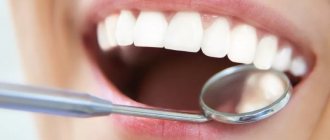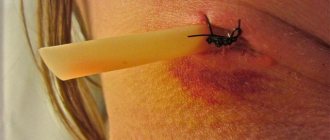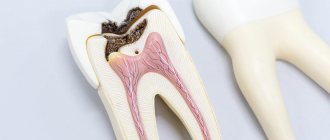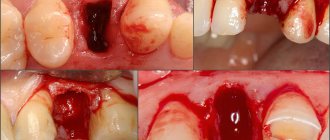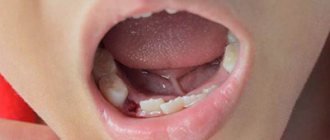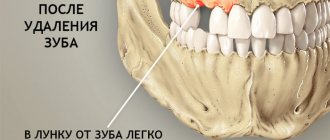Content:
- How does the regeneration process proceed after extraction of the “eight”
- When will the hole heal?
- The main stages of socket healing after wisdom tooth removal
- What determines the speed of regeneration?
Oral care after wisdom tooth removal includes many nuances.
They all pursue one common goal - to prevent infection from entering an unhealed wound, and for regenerative processes to proceed quickly. The dentist tells the patient in detail how to care for a deep hole in the gum, but not all patients listen carefully. Some people deliberately ignore the specialist’s appointments, but in vain. Indeed, with proper wound care, many complications can be avoided.
Why does the hole become dry?
After a tooth is removed, a hole is formed, which should normally be closed by a blood clot. In this situation, it is a barrier to the penetration of infection into the soft periodontal tissues and jaw bone. Considering that the clot is not attached to anything, it is relatively mobile in the alveolus. Chewing on the removal side, brushing teeth or vigorously rinsing the mouth can cause it to fall out, leaving the wound surface exposed to pathogens. Getting inside the wound, they contribute to the development of inflammation. This is manifested by pain of varying degrees of intensity, a disturbance in general well-being, an increase in temperature to subfebrile levels, and in some cases, an enlargement of the submandibular lymph nodes and facial asymmetry.
Other reasons may contribute to the formation of dry socket syndrome:
- Excessive bleeding immediately after extraction. It prevents a clot from forming.
- Resorption of the clot due to the entry of food debris or microorganisms from dental plaque into the socket.
- Incomplete clot formation, which occurs when smoking or taking birth control pills.
A dry socket after tooth extraction usually makes itself felt a few days after the extraction. At the first symptoms - usually a periodic aching pain that intensifies during or immediately after eating - you should come to see the surgeon who performed the removal.
How does the regeneration process proceed after extraction of the “eight”
The socket of an extracted wisdom tooth is always deep. This is due to the structural features of the “eights” - they have tortuous and long roots, which cannot be extracted from the gum tissue atraumatically. Blood flows from the wound for some time. This is due to the rupture of local microvessels. Then she curls up. Then a dense blood clot forms. It is needed to protect tissues from infection.
After the operation, the doctor applies a sterile gauze swab to the hole. To fix it, the patient must close his jaws. This helps stop bleeding as quickly as possible. You need to keep the tampon in place for as long as your doctor tells you. Under no circumstances should you spit it out at the first opportunity.
In the first two days, the clot filling the hole has a rich burgundy color. Under no circumstances should you touch it, let alone try to remove it. It serves as a barrier that prevents germs, bacteria and food debris from entering an unhealed wound.
Starting from the second or third day, the appearance of the clot changes. A light coating forms on its surface. Many people get scared because they think they are releasing pus. There is no need to worry - this is a normal process. The change in the shade of the socket is associated with the formation of new protective epithelial tissue, the basis of which is fibrin protein.
Gradually, the clot dissolves on its own and disappears. A healthy pink mucous membrane is found underneath. This indicates that regeneration was completed successfully.
How long does it take for gums to heal after tooth extraction?
How long does it take for gums to heal after tooth extraction?
Despite the introduction of new methods for diagnosing and treating dental pathology, based on effective innovative technologies, in some cases teeth still have to be removed.
The procedure belongs to the field of surgical dentistry and is a minor surgical intervention. The extraction itself is performed under anesthesia and is not accompanied by pain. The pain appears later, when the effect of the anesthetic has worn off, and it is too early to talk about healing. How long does it take for gums to heal after tooth extraction? What actions help speed up regeneration and minimize the risk of complications? Which symptoms of the recovery period are considered normal, and which signs unmistakably indicate a complication? These and other issues are covered in this publication.
Tooth extraction: specifics of the procedure
Recovery after surgery cannot be considered in isolation from the context, that is, without taking into account the specifics of the surgical intervention and indications for extraction. A dental surgeon can remove a tooth using simple or complex extraction. In the first case, he “pulls out” a defective or diseased element of the dentition without prior preparation of the jaw bone. Complex removal involves preliminary preparation of the bone tissue, which involves drilling or crushing a small area of bone surrounding the roots.
Obviously, the wound heals faster after tooth extraction using a simple method. Tissues are damaged to a lesser extent. The absence of additional manipulations that imply a violation of the integrity of the bone promotes rapid healing. When following the dentist’s recommendations, the patient “forgets” about the operation after about a week, although some precautions must be observed from one to several months, depending on the specifics of the clinical case.
Complex extraction lengthens the rehabilitation period. The gum itself heals quickly after tooth extraction (in one to two weeks), but the restoration of bone tissue will take longer - up to three months. During this time period, the risk of developing negative consequences in the form of inflammatory and infectious processes in bone structures remains. The most common complications of extraction are periostitis (flux) and alveolitis.
How recovery rates depend on indications for extraction
It is impossible to give a universal answer to the question of how long it takes for gums to heal after tooth extraction. The rate of regeneration directly depends on the characteristics of the clinical case, that is, on the indications for extraction. In surgical dentistry, there are several direct indications for the removal of defective or diseased elements:
- Chronic periodontal disease with pathological mobility of teeth 3 degrees.
- Acute purulent periodontitis or exacerbation of chronic periodontitis with localization of the pathological focus at the root apex.
- Radicular cyst in the apical part of the root.
- Severe tooth destruction by caries, which makes prosthetics or restoration using a core insert impossible.
- Longitudinal root fracture.
- Retention or dystopia of an element of the dental system.
- Supernumerary teeth.
- Odontogenic inflammatory process in adjacent structures (trigeminal neuritis, osteomyelitis, sinusitis).
Each patient knows what the reason for removal is in his particular case, but does not always understand how this affects the rate of tissue healing. Let's explain this with a few examples.
In an acute purulent-inflammatory process, there is already a focus of infection in the tissues surrounding the surgical wound. In addition, the tissues are inflamed even before surgery. A similar situation is observed with odontogenic osteomyelitis, inflamed radicular cyst, and odontogenic sinusitis. Obviously, the presence of an infectious-inflammatory process does not contribute to healing after surgery.
The gums will take longer to heal after tooth extraction due to infection. The risk of infectious complications increases significantly, as does the risk of bleeding from a postoperative wound. A course of antibiotics is prescribed not so much to prevent infection, but to suppress the pathogenic microflora initially present in the wound.
We see a different situation when removing impacted or dystopic teeth. Retention is incomplete teething, in which the crown does not rise above the gum at all, or only a small part of it rises. Dystopia is abnormal tooth growth, for example, at an abnormal angle, in the direction of an adjacent element, outside the alveolar arch. Such problems are most typical for wisdom teeth.
Impacted and dystopic teeth can generally be absolutely healthy. There are no carious cavities in them, there is no infection in the surrounding tissues. Initially, the situation is more favorable, because pathogenic microflora can penetrate into the wound only from the oral cavity. This can be counteracted by following your dentist's recommendations. On the other hand, the extensive root system of figure eights with curved roots often forces the dentist to use complex extractions, which causes the tissue to take longer to recover.
Despite the ambiguity of the situation, the gums heal faster after wisdom tooth removal. The risk of undesirable consequences is lower than after extraction of elements affected by infection. The above is also true for supernumerary teeth. They are always deleted; there are no exceptions to this rule.
How to speed up recovery: basic recommendations
The dental surgeon will describe in detail the recovery plan immediately after the operation or even before removal. He will tell you what means to rinse the mouth, what medications to take to reduce swelling and inflammation of the gums, what antibiotics will help prevent infectious complications.
It is advisable to learn about the basic principles of rehabilitation in advance. The following recommendations contribute to the speedy healing of the hole after tooth extraction, regardless of the specifics of the surgical intervention:
- Do not eat for at least three hours. It is advisable to increase this time to 4-5 hours.
- No smoking. Heavy smokers need to take a break for at least three to four hours.
- You should not touch the postoperative wound with your hands or tongue.
- It is advisable not to open your mouth too wide.
- While eating, you need to chew food on the “healthy side” to minimize the penetration of particles into the postoperative wound.
- You can't play sports. The body needs to ensure maximum peace. It is advisable to spend several days at home.
- You need to brush your teeth very carefully so as not to injure your gums.
Now let's talk about medication support during the rehabilitation period. The operation is performed under local anesthesia, the effect of which is limited in time. After 2-3 hours the patient begins to feel pain. The pain is tolerable, but still quite pronounced. To reduce pain, your doctor will usually prescribe strong non-narcotic painkillers, which are available by prescription. Injection forms of release (shots) are more often prescribed because they are more effective. Antihistamines and anti-inflammatory drugs are used to reduce swelling.
The dentist will also prescribe mouth rinses. As a rule, the doctor prescribes antiseptics, which are available without a prescription. For example, dimexide or chlorhexidine. You need to rinse 5-6 times a day. The goal is to suppress pathogenic and opportunistic microflora and prevent infectious complications. Also, gauze swabs soaked in antiseptic should be applied to the wound at the site of the extracted tooth.
It is important to make one note here. In the first days, you need to rinse your mouth very carefully so as not to remove the blood clot from the bone socket. The clot is important for speedy healing - the gums and socket after tooth extraction, with a properly formed clot, heal faster. The doctor monitors the formation of a blood clot after extraction, and then sutures the wound. If careless oral care is taken, the patient runs the risk of washing out the clot, resulting in the gums taking longer to heal.
A preventive course of broad-spectrum antibiotics is prescribed, often in injection form. Injections must be given according to the schedule prescribed by the attending physician. As a rule, injections are given twice a day. In case of a complicated medical history (presence of an infectious focus), the doctor may prescribe a combined course of two drugs. Antibiotics should be used in recommended dosages. You cannot stop the course ahead of time.
In addition to the recommendations listed above, you can use folk remedies. Rinsing with decoctions of medicinal herbs will help speed up recovery. You can use decoctions of oak bark, sage, chamomile, and calendula, which have anti-inflammatory and antiseptic effects. Alcohol tinctures and extracts cannot be used.
Symptoms of the recovery period
Following the doctor’s recommendations speeds up the healing of the hole after tooth extraction and minimizes the risk of complications. However, for 3-5 days the patient may experience the following symptoms:
- increase in body temperature to 37.7-38.5 degrees;
- pain in the area of the postoperative wound;
- slight bleeding from the socket.
These symptoms do not indicate the development of complications; they are characteristic of the normal dynamics of regenerative processes. The next section of the publication will tell you when it’s time to sound the alarm.
Complications and their symptoms
All complications are associated with inflammation and the development of infection at the site of the extracted tooth. The most common complication is alveolitis - inflammation of the bone socket after tooth extraction. Periostitis, an inflammation of the periosteum of the jaw bone, may also develop. Less commonly, a cyst develops at the site of an extracted tooth.
Only a specialist can diagnose the complication. The patient’s task is to suspect the development of a pathological process in a timely manner and promptly seek medical help. You should remain alert for the following symptoms:
- Hyperemia and severe swelling of the gums.
- Repeated heavy bleeding.
- Exacerbation of pain syndrome.
- Temperature rise above 38.5 degrees or 5 days after extraction.
- The appearance of purulent discharge from the wound.
- Swelling of the cheek on the side of the operation.
- Bad breath.
If one or more symptoms of a complication appear, you should contact the doctor who performed the extraction. Delay is fraught with the development of a pathological process with spread to bone tissue. This can lead to osteomyelitis, which is difficult to treat.
Conclusion
With favorable dynamics of regenerative processes, gum healing after tooth extraction occurs within 7 days. After a week, the patient’s general condition returns to normal, and postoperative symptoms no longer bother him.
The socket takes longer to heal, several months, since osteosynthesis proceeds slowly and goes through several stages: the formation of callus, then osteoid, mineralization of organic matter and the formation of full bone. During this time, it is necessary to remain alert for symptoms of possible complications.
The main stages of socket healing after wisdom tooth removal
Conventionally, the regeneration reactions after extraction of the “eight” can be divided into stages. Many of them remain invisible to humans, as they relate to changes occurring in the deep tissues of the gums.
- Stop bleeding. Normally, blood stops flowing within two (maximum four) hours after extraction. On the first day, the patient may still detect a small amount of bloody impurities in the saliva. There's nothing wrong with that.
- Formation of a clot. Occurs on the first day after surgery. Usually at the time of its appearance there is an increase in pain in the wound area and increased swelling. Body temperature may rise slightly. Headaches are also possible. These negative symptoms disappear in one to two days. They usually do not require additional treatment.
- Formation of a thin epithelial layer on top of a blood clot. This stage occurs on the second to fourth days after dental surgery. Then the person sees that the hole has turned white or gray. The state of health at this point usually becomes satisfactory. Toothache no longer bothers me.
- On the fifth to eighth day, the area of gray connective tissue increases rapidly . The clot is visible only in its center. The swelling goes away. If stitches were placed after removal, now is the time to remove them.
- The surface of the wound is covered with granulation tissue. This occurs two to three weeks after removal. As a result, the gums begin to look normal.
- In the period from the third or fourth week to six months, bone tissue grows in the socket.
If the removal was carried out against the background of progressive periodontal disease or periodontitis, then the patient’s recovery period increases by about ten days.
Thus, a month after extraction, a person can chew food on the affected side without restrictions . Nothing will remind him of the previous dental intervention. Since the “eight” is practically not involved in the process of grinding food (that is how far it is located in the dentition) and does not change the appearance of the smile, there is no need for prosthetics in the vacated area.
What complications can tooth extraction lead to?
Normally, restoration of injured tissue occurs within three weeks. The red, inflamed gum gradually acquires a pale pink color and ceases to be painful on palpation. But if a person has diseases that prevent rapid recovery, or he does not comply with doctor’s orders, then the rehabilitation process can be difficult. Then the patient will face complications, including:
- hematoma;
- severe swelling of the soft tissues of the cheek;
- frequent bleeding from the wound;
- numbness of the tongue, cheeks, lips;
- pain while eating.
If the healing of the hole is in doubt - a person thinks that something is going wrong - he should immediately consult a doctor. The doctor will conduct an examination and tell you whether you need to use any drugs to speed up regeneration.
What determines the speed of regeneration?
All people want their mouth wound to heal as quickly as possible. But sometimes recovery takes longer. The speed of recovery processes is reduced:
- poor oral hygiene;
- associated jaw injuries;
- poor-quality tooth extraction (if there are root particles left in the hole);
- development and progression of gingivitis, periodontitis;
- decreased immunity;
- avitaminosis;
- diabetes;
- cavity infection;
- decreased blood clotting;
- hormonal disorders.
In order not to suffer from a slowly healing wound, prepare for the operation competently and follow the doctor’s instructions after it. Then very soon your gum will look like the healthy tissue surrounding it.
Gum healing time
Conventionally, dentists divide the regeneration process into two stages - partial, complete. Partial epithelization is said to occur in the first 12 days after tearing out, and complete epithelialization occurs after 20-25 days. But with complex removal, leading to significant damage to bone tissue and muscles, the recovery period may increase by several more days.
Among the most common reasons causing slow epithelization:
- significant trauma to bone tissue and gums during the intervention (especially if the bone around the diseased tooth was cut out with a drill);
- the occurrence of alveolitis of the inflamed socket;
- damage to the protective clot or its unformation (“dry” hole);
- incomplete removal of bone fragments due to the doctor’s carelessness;
- mobility of the mucous membranes, which needed to be sutured, but for some reason the surgeon decided not to suture;
- refusal to use antibiotics during a severe recovery period;
- diabetes;
- reduced immunity.


